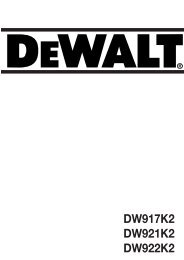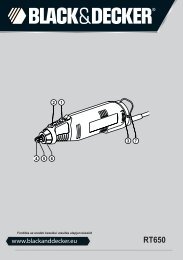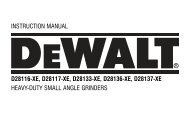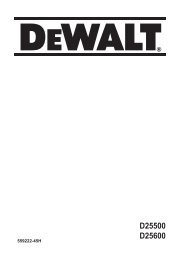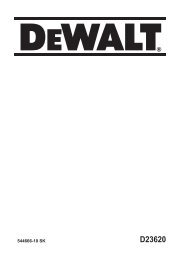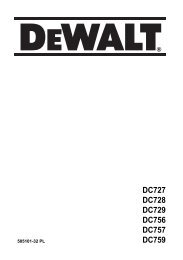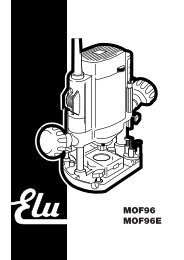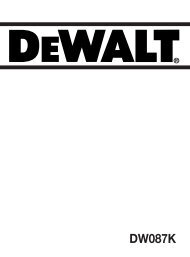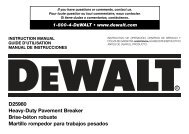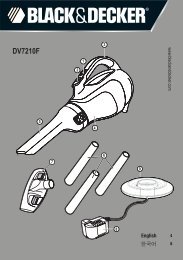Australia - New Zealand - Service - DeWalt
Australia - New Zealand - Service - DeWalt
Australia - New Zealand - Service - DeWalt
- No tags were found...
Create successful ePaper yourself
Turn your PDF publications into a flip-book with our unique Google optimized e-Paper software.
INSTRUCTION MANUALDC415-XEHEAVY-DUTY 36V CORDLESS FINISHING GRINDER
Definitions: Safety GuidelinesThe definitions below describe the level of severity for eachsignal word. Please read the manual and pay attention tothese symbols.DANGER: Indicates an imminently hazardous situationwhich, if not avoided, will result in death or serious injury.WARNING: Indicates a potentially hazardous situationwhich, if not avoided, could result in death or serious injury.CAUTION: Indicates a potentially hazardous situationwhich, if not avoided, may result in minor or moderateinjury.CAUTION: Used without the safety alert symbol indicates apotentially hazardous situation which, if not avoided, mayresult in property damage.IF YOU HAVE ANY QUESTIONS OR COMMENTS ABOUT THIS OR ANY DEWALT TOOL,CALL US AT: 1800 654 155 (Aust) or 09 259 1111 (NZ).SAFETY INSTRUCTIONS FOR POWER TOOLSWhen using power tools, always observe the safety regulations applicable in yourcountry to reduce the risk of fire, electric shock and personal injury. Read the followingsafety instructions before attempting to operate this product. Keep these instructions ina safe place.General Safety RulesWARNING! Read all instructions. Failure to follow all instructions listed belowmay result in electric shock, fire and/or serious injury. The term “power tool” in allof the warnings listed below refers to your mains operated (corded) power tool orbattery operated (cordless) power tool.SAVE THESE INSTRUCTIONS1. WORK AREAa. Keep work area clean and well lit. Cluttered and dark areas invite accidents.b. Do not operate power tools in explosive atmospheres, such as in thepresence of flammable liquids, gases or dust. Power tools create sparkswhich may ignite the dust or fumes.c. Keep children and bystanders away while operating a power tool.Distractions can cause you to lose control.2. ELECTRICAL SAFETYa. Power tool plugs must match the outlet. Never modify the plug in anyway. Do not use any adapter plugs with earthed (grounded) power tools.Unmodified plugs and matching outlets will reduce risk of electric shock.b. Avoid body contact with earthed or grounded surfaces such as pipes,radiators, ranges and refrigerators. There is an increased risk of electricshock if your body is earthed or grounded.c. Do not expose power tools to rain or wet conditions. Water entering a powertool will increase the risk of electric shock.d. Do not abuse the cord. Never use the cord for carrying, pulling orunplugging the power tool. Keep cord away from heat, oil, sharp edgesor moving parts. Damaged or entangled cords increase the risk of electricshock.e. When operating a power tool outdoors, use an extension cord suitablefor outdoor use. Use of a cord suitable for outdoor use reduces the risk ofelectric shock.3. PERSONAL SAFETYa. Stay alert, watch what you are doing and use common sense whenoperating a power tool. Do not use a power tool while you are tired orunder the influence of drugs, alcohol or medication. A moment of inattentionwhile operating power tools may result in serious personal injury.b. Use safety equipment. Always wear eye protection. Safety equipment suchas dust mask, non-skid safety shoes, hard hat, or hearing protection used forappropriate conditions will reduce personal injuries.c. Avoid accidental starting. Ensure the switch is in the off position beforeplugging in. Carrying power tools with your finger on the switch or pluggingin power tools that have the switch on invites accidents.1
• Hold tool by insulated gripping surfaces when performing an operationwhere the cutting tool may contact hidden wiring. Contact with a “live” wirewill make exposed metal parts of the tool “live” and shock the operator.• Do not use Type 11 (flaring cup) wheels on this tool. Using inappropriateaccessories can result in injury.• Before using, inspect recommended accessory for cracks or flaws. If such acrack or flaw is evident, discard the accessory. The accessory should alsobe inspected whenever you think the tool may have been dropped. Flaws maycause wheel breakage.• Do not use circular saw blades or any other toothed blades with this tool.Serious injury may result.• When starting the tool with a new or replacement wheel, or a new orreplacement wire brush installed, hold the tool in a well protected area andlet it run for one minute. If the wheel has an undetected crack or flaw, it shouldburst in less than one minute. If the wire brush has loose wires, they will bedetected. Never start the tool with a person in line with the wheel. This includesthe operator.• Avoid bouncing the wheel or giving it rough treatment. If this occurs, stop the tooland inspect the wheel for cracks or flaws.• Direct sparks away from operator, bystanders or flammable materials. Sparksmay be produced while using a sander or grinder. Sparks may cause burns orstart fires.• Always use side handle. Tighten the handle securely. The side handle shouldalways be used to maintain control of the tool at all times.• Clean out your tool often, especially after heavy use. Dust and grit containingmetal particles often accumulate on interior surfaces and could create a hazard.• Young children and the infirm. This appliance is not intended for use byyoung children or infirm persons without supervision. Young children should besupervised to ensure that they do not play with this appliance.• Replacement of the supply cord. If the supply cord is damaged, it must bereplaced by the manufacturer or an authorised DEWALT <strong>Service</strong> Centre in order toavoid a hazard.WARNING: ALWAYS use safety glasses. Everyday eyeglasses are NOT safetyglasses. Also use face or dust mask if cutting operation is dusty. ALWAYS WEARCERTIFIED SAFETY EQUIPMENT:• ANSI Z87.1 eye protection (CAN/CSA Z94.3),• ANSI S12.6 (S3.19) hearing protection,• NIOSH/OSHA/MSHA respiratory protection.WARNING: Some dust created by power sanding, sawing, grinding, drilling, andother construction activities contains chemicals known to cause cancer, birth defectsor other reproductive harm. Some examples of these chemicals are:• lead from lead-based paints,• crystalline silica from bricks and cement and other masonry products, and• arsenic and chromium from chemically-treated lumber (CCA).Your risk from these exposures varies, depending on how often you do this type ofwork. To reduce your exposure to these chemicals: work in a well ventilated area, andwork with approved safety equipment, such as those dust masks that are speciallydesigned to filter out microscopic particles.• Avoid prolonged contact with dust from power sanding, sawing, grinding,drilling, and other construction activities. Wear protective clothing and washexposed areas with soap and water. Allowing dust to get into your mouth, eyes,or lay on the skin may promote absorption of harmful chemicals.WARNING: Use of this tool can generate and/or disburse dust, which may causeserious and permanent respiratory or other injury. Always use NIOSH/OSHA approvedrespiratory protection appropriate for the dust exposure. Direct particles away fromface and body.WARNING: Always use eye protection. All users and bystanders must wear eyeprotection that conforms to ANSI Z87.1.CAUTION: When not in use, place tool on its side on a stable surface where itwill not cause a tripping or falling hazard. Some tools with large battery packs willstand upright on the battery pack but may be easily knocked over.WARNING: ALWAYS wear proper personal hearing protection that conforms toANSI S12.6 (S3.19) during use. Under some conditions and duration of use, noisefrom this product may contribute to hearing loss.3
• The label on your tool may include the following symbols. The symbols and theirdefinitions are as follows:V ................. voltsA ...............amperesHz ............... hertzW ..............wattsmin ............. minutes ...........alternating current.......... direct current no ..............no load speed.............. Class I Construction .............earthing terminal................... (grounded) .............safety alert symbol............... Class II Construction …/min.......revolutions per minute................... (double insulated) BPM ..........beats per minuteIntroductionThe DC9000-XE charger is designed to charge DEWALT battery packs in approximately1 hour. This charger requires no adjustment and is designed to be as easy as possibleto operate. Simply place your battery pack into the receptacle of a plugged in chargerand it will automatically charge the pack.Important Safety Instruction for Battery PacksWARNING: For safe operation, read this manual and manuals originally supplied withtool before using the charger.When ordering replacement battery packs, be sure to include catalog number andvoltage. Consult the chart on the last page of this manual for compatibility of chargersand battery packs.The battery pack is not fully charged out of the carton. Before using the battery packand charger, read the safety instructions below. Then follow charging proceduresoutlined.READ ALL INSTRUCTIONS• Do not incinerate the battery pack even if it is severely damaged or iscompletely worn out. The battery pack can explode in a fire. Toxic fumes andmaterials are created when lithium ion battery packs are burned.• Do not charge or use battery in explosive atmospheres, such as in thepresence of flammable liquids, gases or dust. Inserting or removing thebattery from the charger may ignite the dust or fumes.• If battery contents come into contact with the skin, immediately wash areawith mild soap and water. If battery liquid gets into the eye, rinse water over theopen eye for 15 minutes or until irritation ceases. If medical attention is needed,the battery electrolyte is composed of a mixture of liquid organic carbonates andlithium salts.• Contents of opened battery cells may cause respiratory irritation. Provide freshair. If symptoms persists, seek medical attention.WARNING: Burn hazard. Battery liquid may be flammable if exposed to spark orflame.• Charge the battery packs only in DEWALT chargers.• DO NOT splash or immerse in water or other liquids.• Do not store or use the tool and battery pack in locations where thetemperature may reach or exceed 40˚C (105°F) (such as outside sheds ormetal buildings in summer).WARNING: Never attempt to open the battery pack for any reason. If battery packcase is cracked or damaged, do not insert into charger. Do not crush, drop or damagebattery pack. Do not use a battery pack or charger that has received a sharp blow, beendropped, run over or damaged in any way (i.e., pierced with a nail, hit with a hammer,stepped on). Damaged battery packs should be returned to service center for recycling.WARNING: Fire hazard. Do not store or carry battery so that metal objects cancontact exposed battery terminals. For example, do not place battery in aprons,pockets, tool boxes, product kit boxes, drawers, etc., with loose nails, screws, keys,etc. Transporting batteries can possibly cause fires if the battery terminalsinadvertently come in contact with conductive materials such as keys, coins,hand tools and the like. The US Department of Transportation Hazardous MaterialRegulations (HMR) actually prohibit transporting batteries in commerce or onairplanes (i.e., packed in suitcases and carry-on luggage) UNLESS they are properlyprotected from short circuits. So when transporting individual batteries, make surethat the battery terminals are protected and well insulated from materials that couldcontact them and cause a short circuit.The RBRC SealTThe RBRC (Rechargeable Battery Recycling Corporation) Sealon the lithium ion battery (or battery pack) indicates that the coststo recycle the battery (or battery pack) at the end of its useful lifehave already been paid by DEWALT.4
RBRC in cooperation with DEWALT and other battery users, has establishedprograms in the United States to facilitate the collection of spent lithium ion batteries.Help protect our environment and conserve natural resources by returning the spentlithium ion battery to an authorized DEWALT service center or to your local retailer forrecycling. You may also contact your local recycling center for information on whereto drop off the spent battery.RBRC is a registered trademark of the Rechargeable Battery Recycling Corporation.Storage Recommendations1. The best storage place is one that is cool and dry away from direct sunlight andexcess heat or cold.2. Long storage will not harm the battery pack or charger. Under proper conditions,they can be stored for 5 years or more.Important Safety Instructions for Battery ChargersSAVE THESE INSTRUCTIONS: This manual contains important safety instructions forbattery chargers.• Before using charger, read all instructions and cautionary markings on charger,battery pack, and product using battery pack.WARNING: Shock hazard. Do not allow any liquid to get inside charger.CAUTION: Burn hazard. To reduce the risk of injury, charge only DEWALT batteries.Other types of batteries may burst causing personal injury and damage.CAUTION: Under certain conditions, with the charger plugged in to the powersupply, the charger can be shorted by foreign material. Foreign materials of aconductive nature such as, but not limited to, steel wool, aluminum foil, or anybuildup of metallic particles should be kept away from charger cavities. Alwaysunplug the charger from the power supply when there is no battery pack in the cavity.Unplug charger before attempting to clean.• DO NOT attempt to charge the battery pack with any chargers other than theones in this manual. The charger and battery pack are specifically designed towork together.• These chargers are not intended for any uses other than charging DEWALTrechargeable batteries. Any other uses may result in risk of fire, electric shockor electrocution.• Do not expose charger to rain or snow.• Pull by plug rather than cord when disconnecting charger. This will reducerisk of damage to electric plug and cord.• Make sure that cord is located so that it will not be stepped on, tripped over,or otherwise subjected to damage or stress.• Do not use an extension cord unless it is absolutely necessary. Use of improperextension cord could result in risk of fire, electric shock, or electrocution.• An extension cord must have adequate wire size (AWG or American WireGauge) for safety. The smaller the gauge number of the wire, the greater thecapacity of the cable, that is 16 gauge has more capacity than 18 gauge.When using more than one extension to make up the total length, be sureeach individual extension contains at least the minimum wire size.MINIMUM GAGE FOR CORD SETSFor Cable length (m): 7.5 15 25 30 45 60Use Cable with minimum rating (Amperes)Tool Amperes0 - 3.4 7.5 7.5 7.5 7.5 7.5 7.53.5 - 5.0 7.5 7.5 7.5 7.5 10 155.1 - 7.0 10 10 10 10 15 157.1 - 12.0 15 15 15 15 20 2012.1 - 20.0 20 20 20 20 25 –• Do not place any object on top of charger or place the charger on a softsurface that might block the ventilation slots and result in excessive internalheat. Place the charger in a position away from any heat source. The charger isventilated through slots in the top and the bottom of the housing.• Do not mount charger on wall or permanently affix charger to any surface. Thecharger is intended to use on a flat, stable surface (i.e., table top, bench top).• Do not operate charger with damaged cord or plug — have them replacedimmediately.• Do not operate charger if it has received a sharp blow, been dropped, orotherwise damaged in any way. Take it to an authorized service center.• Do not disassemble charger; take it to an authorized service center whenservice or repair is required. Incorrect reassembly may result in a risk ofelectric shock, electrocution or fire.5
• Disconnect the charger from the outlet before attempting any cleaning. Thiswill reduce the risk of electric shock. Removing the battery pack will not reducethis risk.• NEVER attempt to connect 2 chargers together.• The charger is designed to operate on standard household electrical power.Do not attempt to use it on any other voltage.SAVE THESE INSTRUCTIONSChargerYour battery pack requires a 1 hour DEWALT charger. Be sure to read all safetyinstructions before using your charger. Consult the chart on the back of thismanual for compatibility of chargers and battery packs.Charging Procedure1. Plug the charger into an appropriate outlet beforeinserting the battery pack.2. Insert the battery pack into the charger. Thecharger is equipped with a three-light fuel gaugethat will blink according to the state of charge ofthe battery pack.3. The completion of charge is indicated by the three red lights remaining ONcontinuously. The pack is fully charged and may be used at this time or left onthe charger.0% - 33% 1 st light blinks33% - 66% 1 st light on, 2 nd light blinks66% - 99% 1 st , 2 nd lights on, 3 rd light blinks100% 1 st , 2 nd , 3 rd lights onCharger DiagnosticsThis charger is designed to detect certain problems that can arise with the batterypacks or the charger. Problems are indicated by the three red lights flashing togetherin different patterns.PROBLEM POWERLINEWhen the charger is used with some portable power sources such as generators orsources that convert DC to AC, the charger may temporarily suspend operation. Thethree red lights will flash together with two fast blinks followed by a pause. Thisindicates that the power souce is out of limits.BAD BATTERYThe charger can detect a weak or damaged battery. The three red lights will flashtogether with rapid blinking. The battery will no longer charge and should be returnedto a service center or a collection site for recycling.BAD CHARGERThe charger will detect if it is not functioning properly. The three red lights will flashtogether with one fast blink followed by a long blink. The charger will no longer workand should be returned to an authorized service center or replaced.LEAVING THE BATTERY IN THE CHARGERThe charger and battery pack can be left connected with the red lights glowingindefinitely. The charger will keep the battery pack fresh and fully charged. Thischarger features an automatic tune-up mode which equals or balances the individualcells in the battery pack to allow it to function at peak capacity. Battery packs shouldbe tuned up weekly or whenever the battery no longer delivers the same amount ofwork. To use the automatic tune-up mode, place the battery pack in the charger andleave it for at least 8 hours.Important Charging Notes1. Longest life and best performance can be obtained if the battery pack is chargedwhen the air temperature is between 18°- 24°C (65°F and 75°F). DO NOT chargethe battery pack in an air temperature below +4.5°C (+40°F), or above +40.5°C(+105°F). This is important and will prevent serious damage to the battery pack.2. The charger and battery pack may become warm to touch while charging. This isa normal condition, and does not indicate a problem. To facilitate the cooling ofthe battery pack after use, avoid placing the charger or battery pack in awarm environment such as in a metal shed, or an uninsulated trailer.3. If the battery pack does not charge properly:a. Check current at receptacle by plugging in a lamp or other applianceb. Check to see if receptacle is connected to a light switch which turns power offwhen you turn out the lights.6
c. Move charger and battery pack to a location where the surrounding airtemperature is approximately 18°- 24°C (65°F - 75°F).d. If charging problems persist, take the tool, battery pack and charger to yourlocal service center.4. The battery pack should be recharged when it fails to produce sufficient power onjobs which were easily done previously. DO NOT CONTINUE to use under theseconditions. Follow the charging procedure. You may also charge a partially usedpack whenever you desire with no adverse affect on the battery pack.5. Foreign materials of a conductive nature such as, but not limited to, steel wool,aluminum foil, or any buildup of metallic particles should be kept away fromcharger cavities. Always unplug the charger from the power supply when thereis no battery pack in the cavity. Unplug charger before attempting to clean.6. Do not freeze or immerse charger in water or any other liquid.WARNING: Shock hazard. Do not allow any liquid to get inside charger.CAUTION: Never attempt to open the battery pack for any reason. If the plastichousing of the battery pack breaks or cracks, return to a service center for recycling.INSTALLING AND REMOVING THE BATTERY PACK (FIG. 1)NOTE: Make sure your battery pack is fully charged.WARNING: To reduce the risk of serious personal injury, make certain the lockoffbutton (B), as shown under Components, is engaged to prevent switchactuation before removing or installing battery.FIG. 1To remove the battery pack from the tool, press the release button (J) and firmly pullthe battery pack out of the tool handle. Insert it into the charger as described in thecharger section of this manual.COMPONENTS (FIG. 2, 3)A. Trigger switch F. Anti-lockup backing flangeB. Lock-Off Button G. Threaded clamp nutC. Spindle lock button H. Guard (Type 1, Type 27)D. Side handle I. Battery packE. Abrasive wheel J. Battery release buttonEFIG. 2CBDAJIJHTo install the battery pack into the tool handle, align the base of the tool with therails inside the tool’s handle and slide the battery pack firmly into the handle until youhear the lock snap into place.7
FIG. 3FASSEMBLY AND ADJUSTMENTSATTACHING SIDE HANDLEThe side handle (D) can be fitted to either side of thegear case in the threaded holes. Before using the tool,check that the handle is tightened se cure ly.To improve user comfort, the gear case will rotate 90˚for cutting operations.ROTATING THE GEAR CASEWARNING: To reduce the risk of serious personalinjury, turn tool off and and remove battery packbefore making any adjustments or removing/installingattachments or accessories.1. Remove the four corner screws attaching the gearcase to motor housing.2. Without separating the gear case from motorhousing, rotate the gear case head to desiredposition.NOTE: If the gear case and motor housing becomeseparated by more than 6.35 mm (1/4"), the tool mustKFGDbe serviced and re-assembled by a DEWALT service center. Failure to have the toolserviced may cause brush, motor and bearing failure.3. Re-install screws to attach the gear case to the motor housing. Tighten screws to2.08 Nm (18 in-lbs.) torque. Overtightening could cause screws to strip.ACCESSORIESIt is important to choose the correct guards, backing pads and flanges to use withgrinder accessories. See pages 9 and 10 for information on choosing the correctaccessories.WARNING: Accessories must be rated for at least the speed recom mended on thetool warning label. Wheels and other accessories running over their rated accessoryspeed may fly apart and cause injury. Threaded accessories must have a 14 x 2 mmhub. Every unthreaded accessory must have a 22.2 mm (7/8") arbor hole. If it does not,it may have been designed for a circular saw. Use only the accessories shown on pages9 and 10 of this manual. Accessory ratings must always be above tool speed as shownon tool nameplate.MOUNTING GUARDMOUNTING AND REMOVING GUARDWARNING: To reduce the risk of serious personal injury, turn tool off and and removebattery pack before making any adjustments or removing/installing attachments oraccessories.CAUTION: Guards must be used with all grinding wheels, cutting wheels, sanding flapdiscs, wire brushes, and wire wheels.The tool may be used without a guard only when sanding with conventional sandingdiscs. DEWALT model DC415 is provided with a guard intended for use withdepressed center wheels (Type 27) and hubbed grinding wheels (Type 27). Thesame guard is designed for use with sanding flap discs (Type 27 and 29) and wirecup brushes. Grinding and cutting with wheels other than Type 27 and 29 requiredifferent accessory guards included with tool. A Type 1 guard is provided for use witha Type 1 wheel. Mounting instructions for these accessory guards are included in theaccessory package.8
115 mm (4-1/2") Grinding WheelsWire WheelsType 27 guardType 27 guardType 27 guardType 27 guardunthreaded backingflangeType 27 hubbed wheel3" wire cupbrush4" wire wheelType 27 depressed centerwheelthreaded clamp nut9
SandingDiscs115 mm (4-1/2") SandingFlap Discs115 mm (4-1/2")Cutting Wheelsrubber backing padType 27 guardType 27 guardType 1 guardType 1 guardsanding discthreaded clamp nuthubbed sanding flapdiscunthreaded backingflangebacking flangebacking flangenon-hubbed sandingflap discabrasive cutting wheeldiamond cutting wheelclamp nutclamp nutthreaded clamp nut10
1. Open the guard latch (L), and align the lugs (M) on theMguard with the slots (N) on the gear case.2. Push the guard down until the guard lugs engageand rotate freely in the groove on the gear case hub.3. With the guard latch open, rotate the guard (H) intothe desired working position. The guard body shouldbe positioned between the spindle and the operator to Nprovide maximum operator protection.L4. Close the guard latch to secure the guard on thegear case. You should not be able to rotate theguard by hand when the latch is closed. Do notoperate the grinder with a loose guard or theclamp lever in open position.5. To remove the guard, open the guard latch,rotate the guard so that the lugs are alignedHwith the slots and pull up on the guard.NOTE: The guard is pre-adjusted to the diameter ofthe gear case hub at the factory. If, after a period oftime, the guard becomes loose, tighten theadjusting screw (O) with clamp lever in the closedposition with guard installed on the tool.CAUTION: If the guard cannot be tightened by theadjusting clamp, do not use the tool. To reduce therisk of personal injury, take the tool and guard to aservice center to repair or replace the guard.OCAUTION: To reduce the risk of damage to thetool, do not tighten the adjusting screw with the clamp lever in the open position.Undetectable damage to the guard or the mounting hub may result.NOTE: Edge grinding and cutting can be performed with Type 27 wheels designedand specified for this purpose; 6.35 mm (1/4") thick wheels are designed for surfacegrinding while 3.17 mm (1/8") wheels are designed for edge grinding. Cutting canalso be performed by using a Type 1 wheel and a Type 1 guard.OPERATIONSwitchLOCK-OFF BUTTON AND TRIGGER SWITCHUNLOCKEDYour cut-off tool is equipped with a lock-offbutton (B).To lock the trigger switch, press the lock-offbutton as shown. When the lock-off button Bis depressed to the lock icon, the unit islocked.Always lock the trigger switch when carryingor storing the tool to eliminate unintentionalLOCKEDstarting.To unlock the trigger switch, press theAlock-off button. When the lock-off button isdepressed to the unlock icon, the unit is unlocked. The lock-off button is colored redto indicate when the switch is in its unlocked position.Pull the trigger switch (A) to turn the tool ON. Releasing the trigger switch turns thetool OFF.NOTE: This tool has no provision to lock the switch in the ON position, and shouldnever be locked ON by any other means.CAUTION: Hold the side handle and body of the tool firmly to maintain control ofthe tool at start up and during use and until the wheel or accessory stops rotating.Make sure the wheel has come to a complete stop be fore laying the tool down.CAUTION: Allow the tool to reach full speed before touching tool to the worksurface. Lift the tool from the work surface before turning the tool off.SPINDLE LOCKThe spindle lock pin is provided to prevent the spindle from rotating when installingor removing wheels. Operate the spindle lock pin only when the tool is turned off, thebattery is removed, and the wheel has come to a complete stop.CAUTION: To reduce the risk of damage to the tool, do not engage the spindle lockwhile the tool is operating. Damage to the tool will result and attached accessory mayspin off possibly resulting in injury.11
To engage the lock, depress the spindle lock button and rotate the spindle until youare unable to rotate the spindle further.MOUNTING AND USING DEPRESSED CENTER GRINDING WHEELSAND SANDING FLAP DISCSMOUNTING AND REMOVING HUBBED WHEELSWARNING: To reduce the risk of serious personal injury, turn tool off and and removebattery pack before making any adjustments or removing/installing attachments oraccessories.Hubbed wheels install directly on the 14 x 2 mm threaded spindle.1. Thread the wheel on the spindle by hand.2. Depress the spindle lock button and use a wrench to tighten the hub of the wheel.3. Reverse the above procedure to remove the wheel.CAUTION: Failure to properly seat the wheel before turning the tool on may result indamage to the tool or the wheel.MOUNTING NON-HUBBED WHEELSWARNING: To reduce the risk of serious personal injury, turn tool off and and removebattery pack before making any adjustments or removing/installing attachments oraccessories.Depressed center Type 27 grinding wheels must be used with included flanges. Seepages 9 and 10 of this manual for more information.F1. Install the anti-lockup backing flange (F) on spindle(P) with the raised section (pilot) against the wheel.Be sure the backing flange recess is seated onto theflats of the spindle by pushing and twisting the flangebefore placing the wheel.2. Place wheel against the backing flange, centeringPthe wheel on the raised section (pilot) of the backingflange.3. While depressing the spindle lock button, thread theclamp nut (G) on spindle. If the wheel you areinstalling is more than 3.17 mm (1/8") thick, placethe threaded clamp nut on the spindle so that theGraised section (pilot) fits into the center of the6.35 mm (1/4") WHEELSwheel. If the wheel you are installing is 3.17 mm(1/8") thick or less, place the threaded clamp nuton the spindle so that the raised section (pilot) isCLAMP NUTnot against the wheel.4. While depressing the spindle lock button, tightenthe clamp nut with a wrench.5. To remove the wheel, depress the spindle lock buttonBACKING FLANGEand loosen the threaded clamp nut with a wrench.NOTE: If the wheel spins after the clamp nut is3.17 mm (1/8") WHEELStightened, check the orientation of the threaded clampnut. If a thin wheel is installed with the pilot on the clampCLAMP NUTnut against the wheel, it will spin because the height ofthe pilot prevents the clamp nut from holding the wheel.SURFACE GRINDING WITH GRINDING WHEELS1. Allow the tool to reach full speed before touching theBACKING FLANGEtool to the work surface.2. Apply minimum pressure to the work surface, allowingthe tool to operate at high speed. Grinding rate isgreatest when the tool operates at high speed.3. Maintain a 20˚ to 30˚ angle between the tool and20˚-30˚work surface.4. Continuously move the tool in a forward and backmotion to avoid creating gouges in the work surface.5. Remove the tool from work surface before turning tool off. Allow the tool to stoprotating before laying it down.EDGE GRINDING WITH GRINDING WHEELSWARNING: Wheels used for cutting and edge grinding may break or kick back ifthey bend or twist while the tool is being used to do cut-off work or deep grinding. Toreduce the risk of serious injury, limit the use of these wheels with a standard Type27 guard to shallow cutting and notching [less than 13 mm (1/2") in depth]. Theopen side of the guard must be positioned away from the operator. For deeper cuttingwith a Type 1 cut-off wheel, use a closed Type 1 guard. See pages 9 and 10 for moreinformation.12
1. Allow the tool to reach full speed before touching the tool to the work surface.2. Apply minimum pressure to the work surface, allowing the tool to operate at highspeed. Grinding rate is greatest when the tool operates at high speed.3. Position yourself so that the open-underside of the wheel is facing away from you.4. Once a cut is begun and a notch is established in the workpiece, do not changethe angle of the cut. Changing the angle will cause the wheel to bend and maycause wheel breakage. Edge grinding wheels are not designed to withstand sidepressures caused by bending.5. Remove the tool from the work surface before turning the tool off. Allow the toolto stop rotating before laying it down.WARNING: Do not use edge grinding/cutting wheels for surface grindingapplications because these wheels are not designed for side pressures encounteredwith surface grinding. Wheel breakage and serious personal injury may result.SURFACE FINISHING WITH SANDING FLAP DISCS1. Allow the tool to reach full speed before touching the tool to the work surface.2. Apply minimum pressure to work surface, allowing the tool to operate at highspeed. Sanding rate is greatest when the tool operates at high speed.3. Maintain a 5˚ to 10˚ angle between the tool andwork surface.4. Continuously move the tool in a forward andback motion to avoid creating gouges in the work5˚-10˚surface.5. Remove the tool from work surface before turning tool off. Allow the tool to stoprotating before laying it down.MOUNTING SANDING BACKING PADSWARNING: To reduce the risk of serious personal injury, turn tool off and and removebattery pack before making any adjustments or removing/installing attachments oraccessories.NOTE: Guard may be removed when using sanding backing padsCAUTION: Proper guard must be reinstalled for grinding wheel, sanding flap disc,wire brush or wire wheel applications after sanding applications are complete.1. Place or appropriately thread backing pad (Q) on the spindle.2. Place the sanding disc (R) on the backing pad (Q).3. While depressing spindle lock, thread clamp nutRS(S) on spindle, piloting the raised hub on theclamp nut into the center of san ding disc andbacking pad.4. Tighten the clamp nut by hand. Then depressthe spindle lock button while turning the sandingdisc until the sanding disc and clamp nut aresnug.5. To remove the wheel, grasp and turn the backingpad and sanding pad while depressing thespindle lock button.QUSING SANDING BACKING PADSChoose the proper grit sanding discs for your application. Sanding discs are available invarious grits. Coarse grits yield faster material removal rates and a rougher finish. Finergrits yield slower material removal and a smoother finish.Begin with coarse grit discs for fast, rough material removal. Move to a medium gritpaper and finish with a fine grit disc for optimal finish.Coarse 16 - 30 gritMedium 36 - 80 gritFine Finishing 100 - 120 gritVery Fine Finishing 150 - 180 grit1. Allow the tool to reach full speed before touching tool to the work surface.2. Apply minimum pressure to work surface, allowing the tool to operate at highspeed. Sanding rate is greatest when the tool operates at high speed.3. Maintain a 5˚ to 15˚ angle between the tool andwork surface. The san ding disc should contactapproximately 25.4 mm (1") of work surface.4. Move the tool constantly in a straight line to prevent5˚-15˚burning and swirling of work surface. Allowing thetool to rest on the work surface without moving, ormoving the tool in a circular motion causes burning and swirling marks on thework surface.5. Remove the tool from work surface before turning tool off. Allow the tool to stoprotating before laying it down.13
Precautions To Take When Sanding Paint1. Sanding of lead based paint is NOT RECOMMENDED due to the difficulty ofcontrolling the contaminated dust. The greatest danger of lead poisoning is tochildren and pregnant women.2. Since it is difficult to identify whether or not a paint contains lead without achemical analysis, we recommend the following precautions when sanding anypaint:PERSONAL SAFETY1. No children or pregnant women should enter the work area where the paintsanding is being done until all clean up is completed.2. A dust mask or respirator should be worn by all persons entering the work area.The filter should be replaced daily or whenever the wearer has difficulty breathing.NOTE: Only those dust masks suitable for working with lead paint dust and fumesshould be used. Ordinary painting masks do not offer this protection. See yourlocal hardware dealer for the proper N.I.O.S.H. approved mask.3. NO EATING, DRINKING or SMOKING should be done in the work area to preventingesting contaminated paint particles. Workers should wash and clean upBEFORE eating, drinking or smoking. Articles of food, drink, or smoking shouldnot be left in the work area where dust would settle on them.ENVIRONMENTAL SAFETY1. Paint should be removed in such a manner as to minimize the amount of dustgenerated.2. Areas where paint removal is occurring should be sealed with plastic sheeting of4 mils thickness.3. Sanding should be done in a manner to reduce tracking of paint dust outside thework area.CLEANING AND DISPOSAL1. All surfaces in the work area should be vacuumed and thoroughly cleaned dailyfor the duration of the sanding project. Vacuum filter bags should be changedfrequently.2. Plastic drop cloths should be gathered up and disposed of along with any dustchips or other removal debris. They should be placed in sealed refuse receptaclesand disposed of through regular trash pick-up procedures.During clean up, children and pregnant women should be kept away from theimmediate work area.3. All toys, washable furniture and utensils used by children should be washedthoroughly before being used again.MOUNTING AND USING WIRE BRUSHES AND WIRE WHEELSWire cup brushes or wire wheels screw directly on the grinder spindle without the useof flanges. Use only wire brushes or wheels provided with a 14 x 2 mm threaded hub.A Type 27 guard is required when using wire brushes and wheels.CAUTION: To reduce the risk of personal injury, wear work gloves when handling wirebrushes and wheels. They can become sharp.CAUTION: To reduce the risk of damage to the tool, wheel or brush must not touch guardwhen mounted or while in use. Undetectable damage could occur to the accessory,causing wires to fragment from accessory wheel or cup.MOUNTING WIRE CUP BRUSHES AND WIRE WHEELSWARNING: To reduce the risk of serious personal injury, turn tool off and and removebattery pack before making any adjustments or removing/installing attachments oraccessories.1. Thread the wheel on the spindle by hand.2. Depress spindle lock button and use a wrench on the hub of the wire wheel orbrush to tighten the wheel.3. To remove the wheel, reverse the above procedure.CAUTION: To reduce the risk of damage to the tool, properly seat the wheel hub beforeturning the tool on.USING WIRE CUP BRUSHES AND WIRE WHEELSWire wheels and brushes can be used for removing rust, scale and paint, and forsmoothing irregular surfaces.NOTE: The same precautions should be taken when wire brushing paint as whensanding paint (Refer to Precautions To Take When Sanding Paint).1. Allow the tool to reach full speed before touching the tool to the work surface.2. Apply minimum pressure to work surface, allowing the tool to operate at highspeed. Material removal rate is greatest when the tool operates at high speed.14
3. Maintain a 5˚ to 10˚ angle between the tool and worksurface for wire cup brushes.4. Maintain contact between the edge of the wheel andthe work surface with wire wheels.5. Continuously move the tool in a forward and back5˚-10˚motion to avoid creating gouges in the work surface.Allowing the tool to rest on the work surface withoutmoving, or moving the tool in a circular motion causes burning and swirlingmarks on the work surface.6. Remove the tool from the work surface before turning the tool off. Allow the toolto stop rotating before setting it down.CAUTION: Use extra care when working over an edge, as a sudden sharpmovement of grinder may be experienced.MOUNTING AND USING CUTTING (TYPE 1) WHEELSCutting wheels include diamond wheels and abrasive discs. Abrasive cutting wheelsfor metal and concrete use are available. Diamond blades for concrete cutting canalso be used.WARNING: A closed, 2-sided cutting wheel guard is included with this tool and isre quired when using cutting wheels. Fail ure to use proper flange and guard can re sultin injury resulting from wheel breakage and wheel contact. See pages 9 and 10 formore information.MOUNTING CLOSED (TYPE 1) GUARDUWARNING: To reduce the risk of serious personalinjury, turn tool off and and remove battery packbefore making any adjustments or removing/installingattachments or accessories.1. Open the guard latch (L), and align the lugs (T) onthe guard with the slots on the hub (U).TL2. Push the guard down until the guard lug engagesand rotates freely in the groove on the gear case hub.3. Rotate guard (H) into desired working position. The guard body should be positionedbetween the spindle and the operator to provide maximum operator protection.4. Close the guard latch to secure the on guard thegear case cover. You should be unable to rotatethe guard by hand when the latch is in closedposition. Do not operate grinder with a looseguard or clamp lever in open position.5. To remove the guard, open the guard latch, rotatethe guard so that the lugs and slots are alignedHand pull up on the guard.NOTE: The guard is pre-adjusted to the dia met er of thegear case hub at the factory. If, after a period of time, theguard becomes loose, tighten the adjusting screw (O)with the clamp lever in the closed position with guard Oinstalled on the tool.CAUTION: To reduce the risk of damage to the tool, do nottighten adjusting screw with clamp lever in open position.Undetectable damage to guard or mounting hub mayresult.MOUNTING CUTTING WHEELSWARNING: To reduce the risk of serious personal injury, turn tool off and and removebattery pack before making any adjustments or removing/installing attachments oraccessories.CAUTION: Matching diameter threaded backing flange and clamp nut (included withtool) must be used for cutting wheels.1. Place the unthreaded backing flange on spindle with the raised section (pilot)facing up. The raised section (pilot) on the backing flange will be against thewheel when the wheel is installed. Be sure the backing flange recess is seatedonto the flats of the spindle by pushing and twisting the flange before placing thewheel.2. Place the wheel on the backing flange, centering the wheel on the raised section(pilot).3. Install the threaded clamp nut with the raised section (pilot) facing away from thewheel.4. Depress the spindle lock button and tighten clamp nut with a wrench.5. To remove the wheel, grasp and turn while depressing the spindle lock button.15
USING CUTTING WHEELSWARNING: Do not use edge grinding/cutting wheels for surface grinding applicationsbecause these wheels are not designed for side pressures encountered with surfacegrinding. Wheel breakage and injury may result.1. Allow tool to reach full speed before touching tool to work surface.2. Apply minimum pressure to work surface, allowing tool to operate at high speed.Cutting rate is greatest when the tool operates at high speed.3. Once a cut is begun and a notch is established in the workpiece, do not changethe angle of the cut. Changing the angle will cause the wheel to bend and maycause wheel breakage.4. Remove the tool from work surface before turning tool off. Allow the tool to stoprotating before setting it down.Causes and Operator Prevention of Kickback• Kickback is a sudden reaction to a pinched, bound or misaligned wheel, wirebrush or flap disc causing an uncontrolled cut-off tool to lift up and out of theworkpiece toward the operator.• When the wheel is pinched or bound tightly by the workpiece, the wheel stallsand the motor reaction drives the unit rapidly back toward or away from theoperator.• Kickback is the result of tool misuse and/or incorrect operating procedures orconditions and can be avoided by taking proper precautions as given below:• Maintain a firm grip with both hands on the unit and position your body andarm to allow you to resist kickback forces. Kickback forces can be controlledby the operator, if proper precautions are taken.• When wheel is binding, or when interrupting a cut for any reason, release thetrigger and hold the unit motionless in the material until the wheel comes to acomplete stop. Never attempt to remove the unit from the work or pull the unitbackward while the wheel is in motion or kickback may occur. Investigate andtake corrective actions to eliminate the cause of wheel binding.• When restarting a cut-off tool in the workpiece, check that the wheel is notengaged into the material. If wheel is binding, it may walk up or kickback fromthe workpiece as the tool is restarted.• Support large panels to minimize the risk of wheel pinching and kickback.Large panels tend to sag under their own weight. Support must be placed underthe panel on both sides, near the line of cut and near the edge of the panel.MAINTENANCEWARNING: Shock Hazard. To reduce the risk of serious personal injury, turntool off and disconnect tool from power source before making any adjustments orremoving/installing attachments or accessories.CleaningWARNING: Blow dirt and dust out of all air vents with clean, dry air at least oncea week. To minimize the risk of eye injury, always wear ANSI Z87.1 approved eyeprotection when performing this.CAUTION: Never use solvents or other harsh chemicals for cleaning the nonmetallicparts of the tool. These chemicals may weaken the plastic materials used inthese parts. Use a cloth dampened only with water and mild soap. Never let any liquidget inside the tool; never immerse any part of the tool into a liquid.CHARGER CLEANING INSTRUCTIONSWARNING: Shock hazard. Disconnect the charger from the AC outlet beforecleaning. Dirt and grease may be removed from the exterior of the charger using acloth or soft non-metallic brush. Do not use water or any cleaning solutions.LubricationYour tool was properly lubricated before leaving the factory. In from two to sixmonths, depending upon use, take or send your tool to an authorized servicecenter for a complete cleaning, inspection and lubrication. Tools used constantly onproduction jobs will need relubrication more often. Also, tools “out of service” for longperiods should be relubricated before being put back to work.RepairsThis charger is not user serviceable. There are no user serviceable parts inside thecharger. Servicing at an authorized service center is required to avoid damage to staticsensitive internal components.16
To assure product SAFETY and RELIABILITY, repairs, maintenance and adjustment(including brush inspection and replacement) should be performed by certifiedservice centers or other qualified service organizations, always using identicalreplacement parts.ACCESSORIESWARNING: Since accessories, other than those offered by DEWALT, have not beentested with this product, use of such accessories with this tool could be hazardous.To reduce the risk of injury, only DEWALT, recommended accessories should be usedwith this product.Recommended accessories for use with your tool are available at extra cost fromyour local service center. If you need any assistance in locating any accessory,please contact DEWALT Industrial Tool Co., 20 Fletcher Road, Mooroolbark, VIC 3138<strong>Australia</strong> or call 1800 654 155 or (NZ) 09 259 1111.GuaranteeApplicable to hand held Power Tools, Lasers and Nailers.Three Year Limited WarrantyDEWALT will repair, without charge, any defects due to faulty materials orworkmanship for three years from the date of purchase. Please return the completeunit, transportation prepaid, to any DEWALT <strong>Service</strong> Centre, or any authorisedservice station.For warranty repair information, call (AUS) 1800 654 155 or (NZ) 09 259 1111.This warranty does not apply to• Accessories• Damage caused where repairs have been made or attempted by others.• Damage due to misuse, neglect, wear and tear, alteration or modification.This warranty gives you specific legal rights and you may have other rights under theprovisions of the Consumer Guarantee Act 1993 (<strong>New</strong> <strong>Zealand</strong> only), Trade PracticesAct 1974 and State Legislation (<strong>Australia</strong> only).In addition to the warranty, DEWALT tools are covered by our:FREE ONE YEAR SERVICE CONTRACTDEWALT will also maintain the tool for free at any time during the first year ofpurchase. This includes labour, parts and lubrication required to restore the product tosound mechanical and/or electrical condition. Normal wear parts are not covered inthis service. Carbon brushes worn more then 50% will be replaced.NOTE: Three Year Warranty is not applicable to items deemed as consumables. Radialarm saws are covered by a one (1) year warranty only. DEWALT Reserves the right toreview its warranty policy prior to launch of any new business development products.30 DAY NO SATISFACTION GUARANTEEIf you are dissatisfied with any DEWALT power tool, laser or nailer, for any reason,simply return it to the point of purchase with your sales receipt within 30 days for areplacement unit or a full refund.FREE WARNING LABEL REPLACEMENT: If your warning labels become illegible orare missing, call (AUS) 1800 654 155 or (NZ) 09 259 1111 for a free replacement.17




